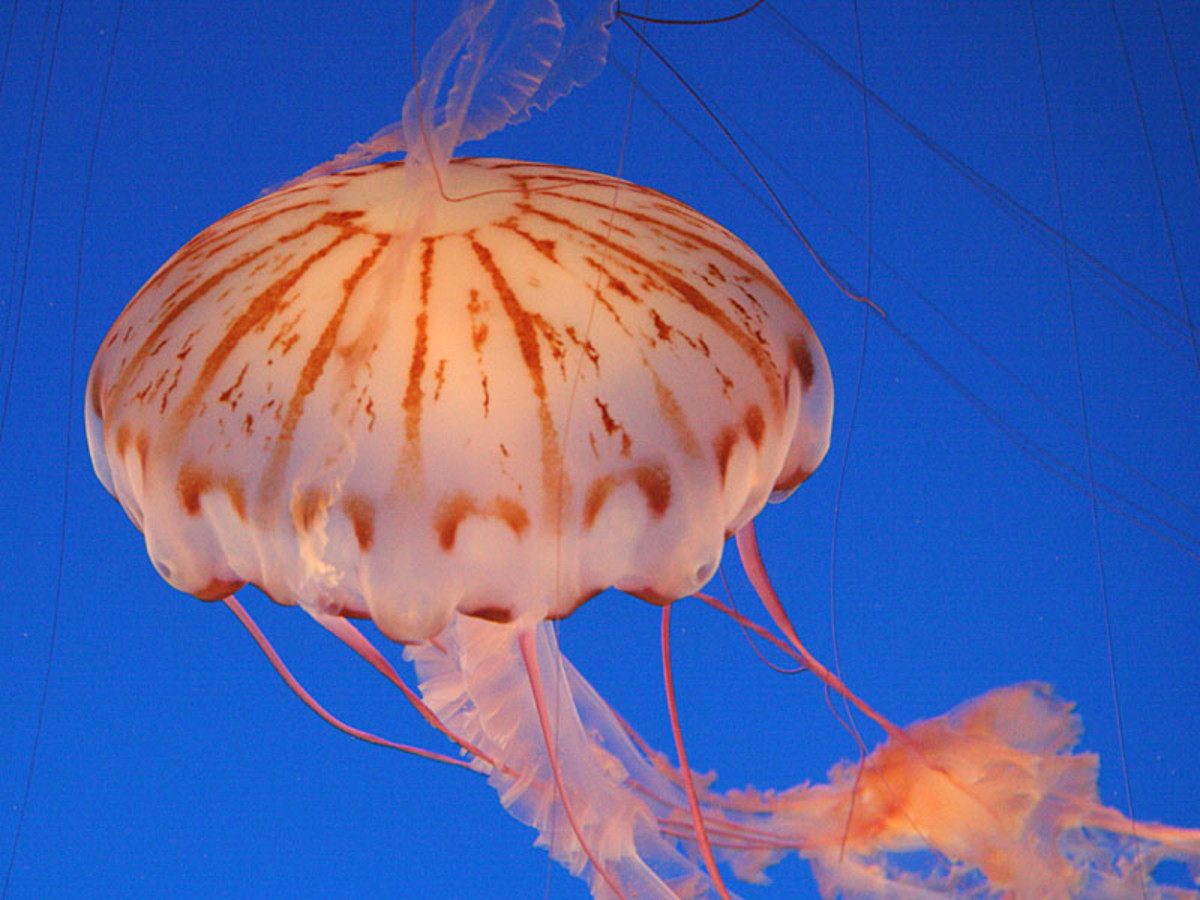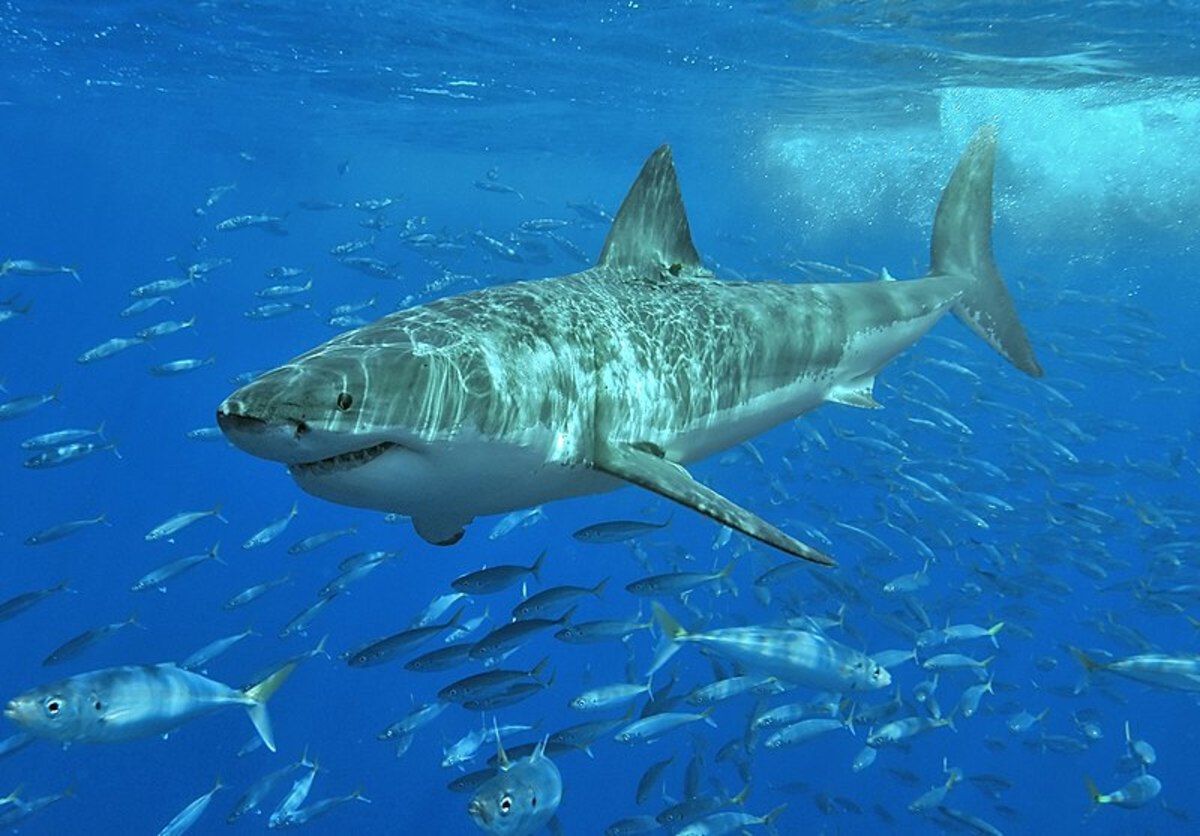- HubPages»
- Education and Science»
- Life Sciences»
- Marine Biology»
- Marine Life
The 5 Deadliest Sharks to Humans
Although the majority of sharks do not intentionally set out to harm humans, there are still a certain few that have the potential and the means to cause immense damage to us.
Whether or not sharks pose a danger to humans does not necessarily depend on the number of victims that their kind has accumulated throughout history; instead, it is important to take into consideration the proximity that their specific habitats are in relation to our own. Other factors to consider are the shark's behaviors: whether or not they are known to be territorial and aggressive towards humans and also the time of day that they are most likely to be active. A shark is less likely going to pose a threat if it is active at night while the majority of human beings are more active during the day.
Nonetheless, whether you spend your time near the shore or venture out into open water, it is important to know which type of sharks that you might be up against---- and the likelihood that you might encounter trouble.
5. Blacktip Shark

Danger to Humans
The blacktip shark has been implicated in a number of non-fatal attacks on humans. Reports say that this species shows curiosity towards divers, but because of its timidness, it often stays at a safe distance, and does not pose that much of a threat; however, it is known to become aggressive in the presence of food.
Statistically speaking, this species of shark has only been responsible for 16% of the annual shark attacks off the Florida coast, and most of the attacks consist of only minor wounds. It is important to clarify that we pose more of a threat to the blacktip shark than it is to humans.
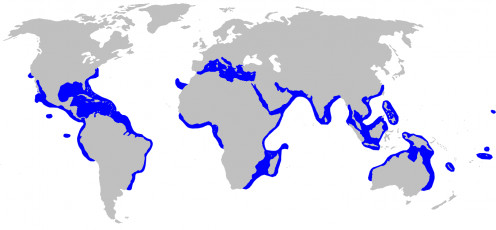
General Information
Appearance
- Color- Dark gray, blue gray or dusky bronze above; white below
- Distinctive Features- Black tipped fins; pointed snout, small eyes; 5 gill slits that are longer than other requiem shark species
- Size- Males (5.9ft); females (6ft); the largest shark caught was female (8.1ft)
Distribution & Habitat
- Lives in tropical and subtropical waters worldwide, and is often found in shallow areas along the different coastlines.
- Favored habitats are muddy bays, island lagoons, and the drop-offs near coral reefs
Behavior
- This shark is active, often seen spinning and jumping above the surface
- If threatened, they often perform agonist display; to do this, the shark will swim towards the specific threat, turn away, tilt from side to side, lower its pectoral fins, tilts its tail and snout upwards.
4. Oceanic Whitetip
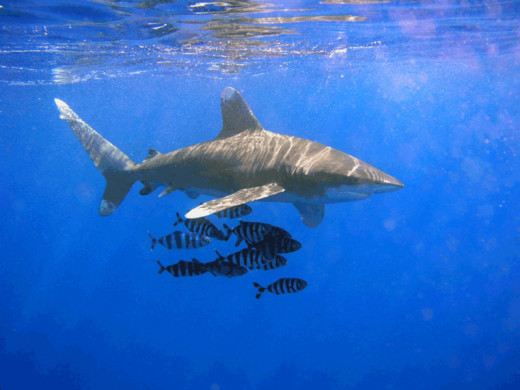
Danger to Humans
The oceanic whitetip is very bold and persistent, especially when competing for food. The danger posed by this shark may be questionable considering that this species lives in deep water as opposed to shallow shores.
Although this species has statistically only been responsible for only a minor amount of unprovoked attacks throughout history, the majority of their victims have gone unreported and unnoticed because they were most likely killed off shore (in ship wrecks and plane crashes). The oceanic whitetip is actually thought to be responsible for claiming the most human lives--- which would even outnumber the victims of the Great White.
Aside from the speculation, the oceanic whitetip statistically, has been responsible for only 10 attacks on humans, and has also been implicated in a number of unprovoked incidents involving swimmers and snorkelers. Victims have reported that this shark is very persistent. When fended off, the shark often returns, circles around, and approaches again. Its opportunistic feeding habits, larger build, and its stubbornness indicate that it should be treated with caution.
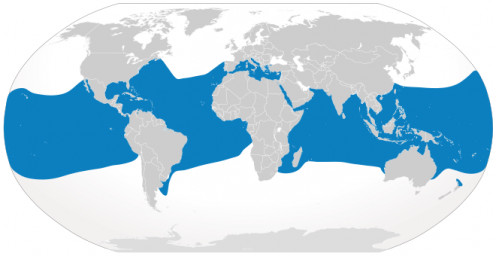
General Information
Appearance
- Distinctive features- Large body; large, rounded white-tipped fins; high rounded dorsal fin; long, paddle-shaped pectoral fins
- Color- Gray and bronze top body; white below; white tipped dorsal and pectoral fins
- Size- Ranges from 9.8ft. and the largest being 13ft.
Distribution & Habitat
- This shark can be found in all temperate and tropical waters that have temperatures ranging from at least 68 to 82 degrees Fahrenheit.
- Differing from sharks that reside near coastlines, this shark lives the majority of its life in extremely deep, open seas; however, some have been found off the coasts of different tropical islands (in waters of at least 120ft).
Behavior
- Lacks of diurnal cycle--- thus, it is active both day and/or night.
- Solitary and slow moving, preferring to cruise leisurely near the surface.
3. Tiger Shark

Danger to Humans
The tiger shark is responsible for a large percentage of attacks on humans, and is responsible for the largest number of fatalities second to the Great White. It is one of the three most dangerous shark species known to man. Despite the danger they pose to humans, however, attacks on humans is a relatively rare phenomenon these days.
One of the reasons they are considered so dangerous to humans is due to the fact that they often visit shallow reefs, harbors, and canals, which creates the potential for encountering humans.On average, three to four shark attacks occur per year in Hawaii, but the majority of attacks are not fatal. This attack rate is surprisingly low considering thousands of people swim, surf, and dive in Hawaiian waters every day.
It might be odd that the tiger shark is only #3 on the list, given the number of attacks that have been ascribed to tiger sharks as well as the fact that they are extremely curious creatures that will take a bite out of anything. The tiger shark is listed at #3 because they are mostly found closer to shore during the night, and retreat to deeper waters in the daytime, when swimmers and beach-goers are most active.
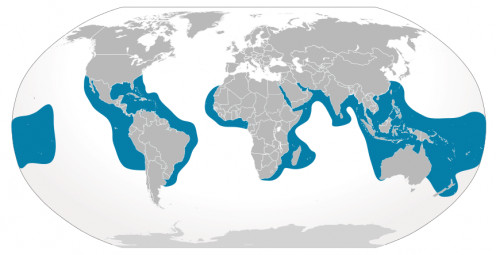
General Information
Appearance
- Distinctive Features- Long, large body; flat and edgy snout; tiger "striped" appearance which allows them to camouflage into coastal habitats.
- Color- Varies from brownish gray, black, olive, and dirty yellow.
- Size- Commonly, tiger sharks range from about 9.8ft to 13.8ft. but the largest caught have been a 15ft male and a 16ft female.
Distribution & Habitat
- Tiger sharks are found almost worldwide in tropical and mild coastal regions, preferring murky waters and estuaries. In addition to these areas they are often found near island groups such as the Marshall Islands, Hawaii, Tahiti or the Galapagos.
- Although it has been found in oceanic waters as deep as 1,000ft., it is regarded as a coastal creature, and it can tolerate a variety of habitats including estuaries, river mouths, and lagoons.
Behavior
- The tiger shark is rather solitary, often preferring to swim and hunt alone, but can also travel in a small pack of up to six other sharks of its species.
- The tiger shark is nocturnal, and is mostly active at dusk or at night, and their activity ranges depending on the region and time of day.
- They often are found in shallower waters during nighttime, and retreat to deeper waters during the day.
- Tiger sharks tend to swim slowly, but stealthily, allowing them to creep up and surprise their prey; however, despite appearing to swim sluggishly, tiger sharks are one of the strongest swimming sharks
2. Great White Shark
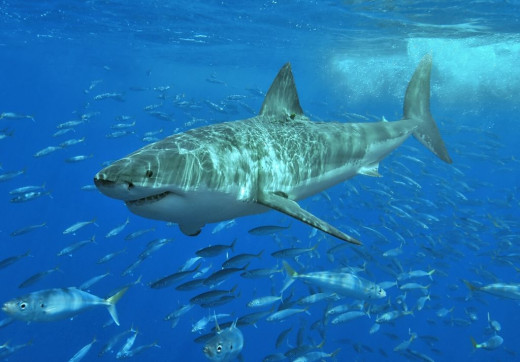
Danger to Humans
Ah, the great white shark. Although movies like Jaws tends to depict the great white as an intelligent, massive killing machine, the great white does not seek out humans, nor does it mean to wreak havoc for avid surfers and beach lovers.
Also known as the white pointer, white shark, or white death, the great white shark is responsible for the majority of all unprovoked attacks on humans, but there is also speculation that the great white, statistically, has been mistaken for other sharks.
That all being said, the great white shark is a curious creature, and it learns by experience. This species has poorer eyesight than other sharks, and it often uses its senses in order to sight potential food. Great whites use their teeth to inspect unfamiliar objects, and due to its mammoth size and jaws, taking a bite out of a human can be deadly. If great whites do not like what they taste, they do not return for more like other sharks. Instead, they move on in search of something better.
The Shark Attack File states:
In terms of its danger to humans, the shark is usually indifferent to divers. However, this species has been implicated in numerous unprovoked bites on swimmers, surfers and divers. Most bites by white sharks are not fatal, but incidents in which a white shark partially consumed a human have occurred.
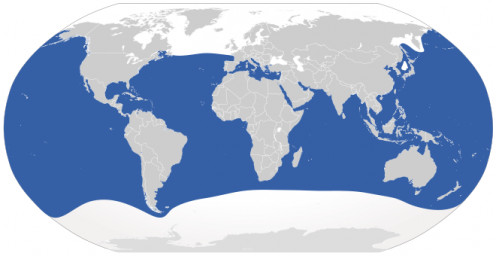
General Information
Appearance
- Distinctive Features- Robust, large snout; mottled appearance; heavy spindle-shaped body
- Color- White underbelly; grey dorsal area (sometimes brown or a blue shade).
- Size- Females are normally larger than males, maturing to a size approximately (14.8- 16.4ft); Mature males grow to be approximately (11.5-13.1ft.) long.
Distribution & Habitat
- Temperate, subtropical, and tropical waters.
- The great white population is distributed worldwide, and it can be found in any coastal or offshore waters that have a temperature ranging between 54 to 74 degrees.
Behavior
- The great white is a super predator, and is the most formidable sharks.
- This shark swims stiffly, but is able to accelerate its speed rather quickly.
- It sometimes raises its head above the water, especially when scoping out seal colonies and seagulls.
1. Bull Shark
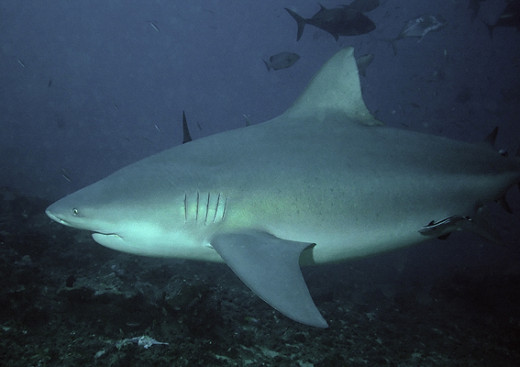
Danger to Humans
You might be wondering, how is the bull shark #1 considering that the shark species that are responsible for the most attacks are the tiger and the great white? The bull shark may be behind in statistics, but there has been a lot of speculation as to whether the great white and tiger have been blamed for many attacks that were carried out by a bull shark.
Bull sharks are aggressive, common, and usually live near high-population areas like tropical shorelines. Because of these characteristics, there are many researchers today that dub the bull shark "the most dangerous shark species in the world." It is due to the fact that they dwell in shallow, coastal waters, that bull sharks are the most dangerous to humans.
Ironically, a shark attack on a boy swimming at the Jersey Shore in 1916 was the inspiration for the movie, Jaws; however, the boy was not attacked by a great white. Guess which shark species was actually responsible? The bull shark. Take caution when swimming in shallow waters, salt or fresh, because if you run into a bull shark, they won't hesitate to "bump-and-bite" you.
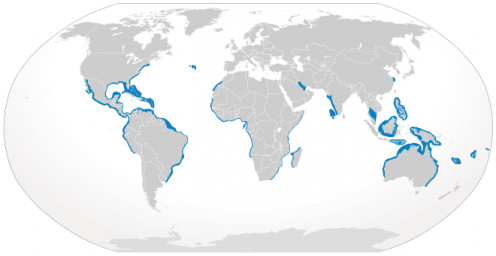
General Information
Appearance
- Distinctive Features- Short, rounded snout; strikingly small eyes; the most distinctive feature, however, is their dorsal fin which is shaped like a triangle.
- Color- Their body colors are subdued; dark gray/black top; white underbelly.
- Size- Bull sharks range from 7 to 11.5ft., and females are slightly larger than males.
Distribution & Habitat
- Worldwide, the bull shark can be found in all tropical and subtropical waters.
- They prefer to live in shallow coastal areas of warm oceans, in rivers, lakes, and occasionally salt and freshwater streams if they are deep enough.
- Bull sharks can also be found in fresh water that connects with salt water and have been caught in the Mississippi River as far upstream as Illinois.
Behavior
- Fast, agile predators, they will eat almost anything they see, including fish, dolphins, and even other sharks.
- They are an opportunistic species, and are solitary hunters.
- They are best known by their aggressive and territorial behavior.

